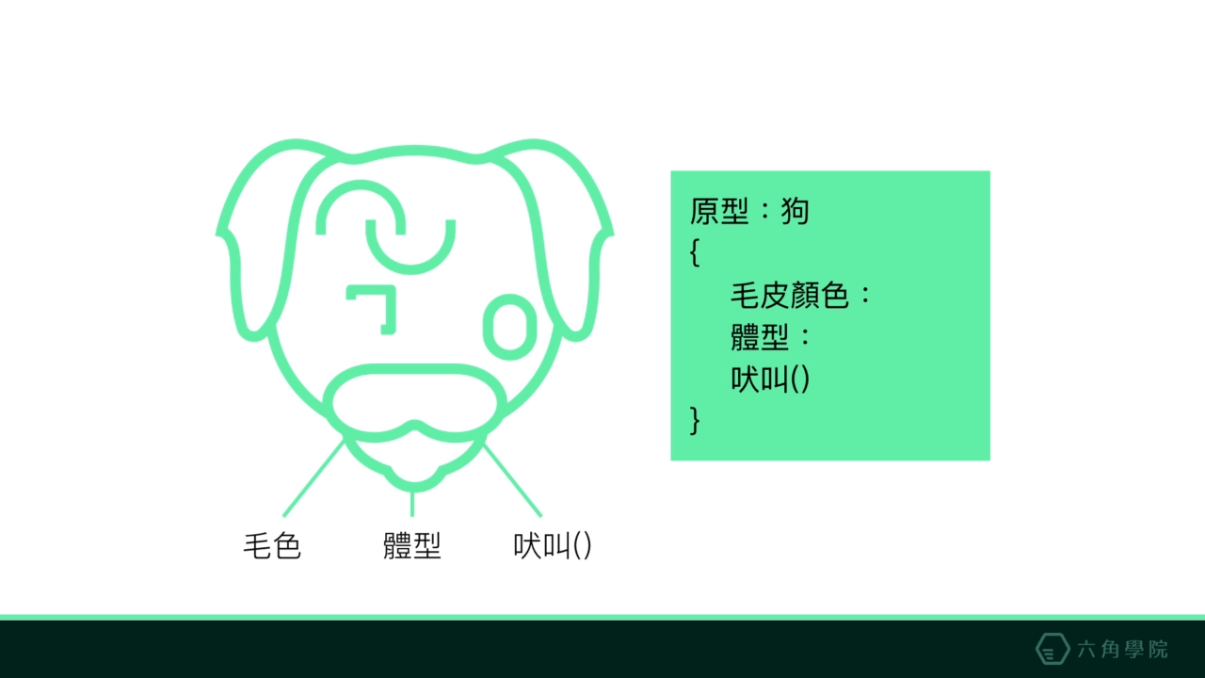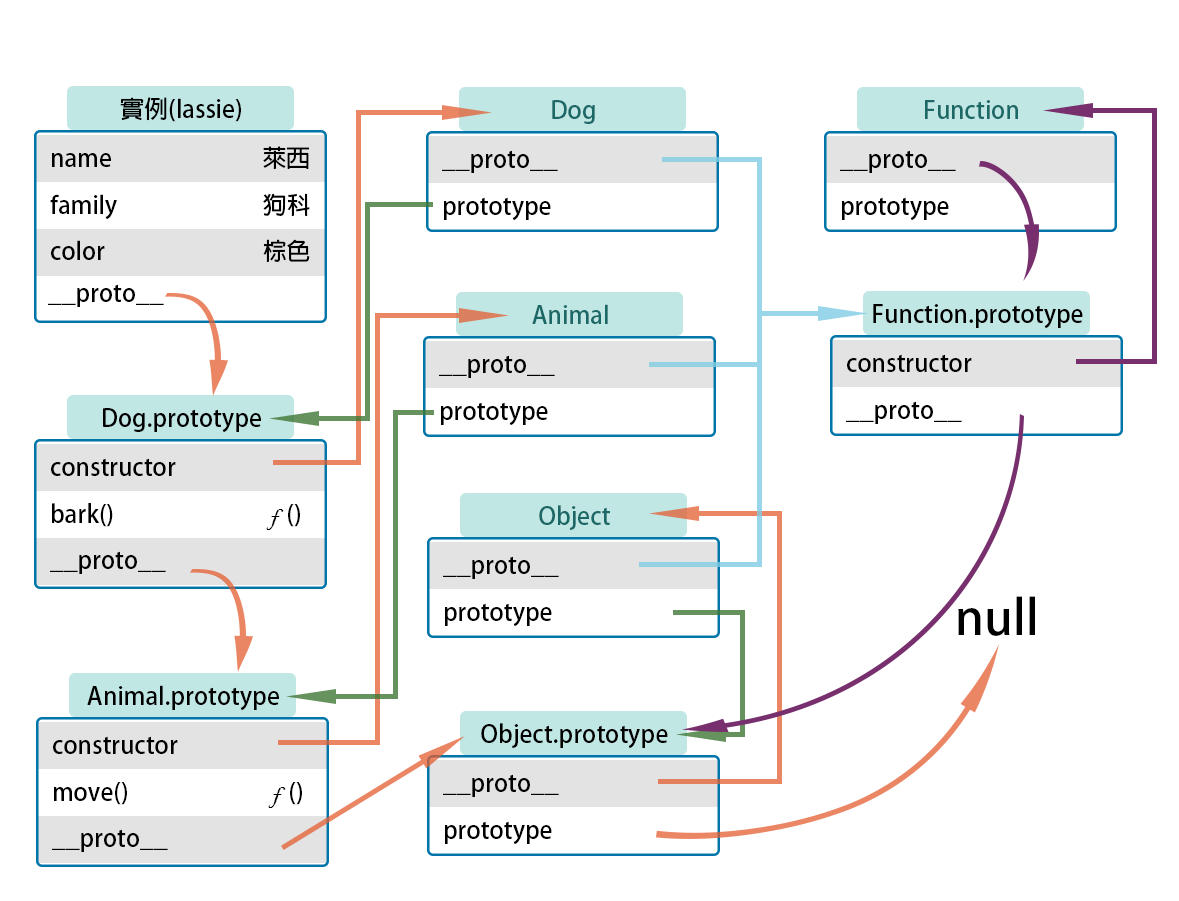原型
Javascript 是 原型架構的程式語言(prototype-base-oriented) 的語言,class 並不存在。在它的世界裏只有 物件(Object) 和 實例(Instance)。原型物件 作為範本物件,用以繼承函式與屬性。物件的原型物件可能也具備原型物件,並繼承了其上的函式與屬性。
這些屬性與函式都是透過物件的建構子函式所定義,並非物件實例本身。原型鍊 (Prototype chain) 」。
物件的原型物件可能也具備原型物件,並繼承了其上的函式與屬性。
原型物件
function Dog (breed, color, size ) this .breed = breed; this .color = color; this .size = size }
對建構函式使用 new ,就會生成一個實例。
var Lassie = new Dog('牧羊犬' , '棕色' , '中' );var Lala = new Dog('拉布拉多' , '黑' , '大' )console .log(Lassie, Lala)
生成兩個實例對象,這兩個對象的species屬性是獨立的,修改其中一個,不會影響到另一個。
prototype 屬性的引入prototype 屬性,所有實例對象需要共享的屬性和方法,都放在這個對象裡面;那些不需要共享的屬性和方法,就放在建構函式裡面。prototype 對象的屬性和方法。
console .dir(Dog)Dog.prototype.bark = function ( console .log('吠叫' ); } Lassie.bark(); Lala.bark();
屬性 & 方法放在 prototype 對象裡,是兩個實例對象共享的。只要修改了 prototype 對象,就會同時影響到兩個實例對象。
graph LR
A(Lassie) -->|Inherits from
__proto__ : 它的出現是為了解決讀寫 Object.prototype 的麻煩,提供一個快捷讀寫 Object.prototype 而設的一個 API,而且它是透過連結內部屬性 [[Prototype]]完成這個功能。prototype : 使用於原型的函式上。console.log(Dog.prototype === Lassie.__proto__) //true
原始型別的包裹物件與原型的關聯
原始型別 與 原始型別的建構式(包裹物件) 也指向相同的原型。
var a = 1 ;typeof (a) a.__proto__ === Number .prototype
如果於原始型別的建構式(包裹物件)新增一個原型方法,原始型別也可同時使用此方法。
String .prototype.lastText = function ( return this [this .length-1 ] } var a = "ABCDE" console .log(a.lastText()) Number .prototype.sqare = function ( return this * this } var b = 5 console .log(b.sqare())
JavaScript有許多的建構式,也可使用此方式建立自定的原型方法。
var date = new Date ()Date .prototype.getFullDate = function ( let yyyy = this .getFullYear(); let mm = ((this .getMonth() + 1 ) < 10 ? '0' : '' ) + (this .getMonth() + 1 ); let dd = (this .getDate() < 10 ? '0' : '' ) + this .getDate(); return `${yyyy} -${mm} -${dd} ` } console .log(date.getFullDate())
建立自己的原型練吧! Object.create()
使用 new 一個建構式來產生一個實例,此時實例是繼承在 Object 之下的。
Object > 建構式 > 實例
但如想 Object 以及 建構式 當中新增一個 建構式 以達到多層繼承的目的時,可使用 Object.create() 此方法。
Object > 建構式1 > 建構式2 > 實例
透過 Object.create() 可以建立一個空物件,同時可以將你帶入 Object.create() 的參數內容變成該物件的原型。
function Animal (family ) this .kingdom = '動物界' ; this .family = family || '人科' ; } Animal.prototype.move = function ( return `${this .name} 移動` } function Dog (name, color, size ) this .name = name; this .color = color || '白' ; this .size = size || '大' ; } Dog.prototype = Object .create(Animal.prototype) Dog.prototype.bark = function ( return `${this .name} 吠叫` } var lassie = new Dog('萊西' , '棕' , '中' )console .dir(lassie)
對新增的實例(lassie)使用Dog的原型方法以及Animal的原型方法。
console .log(lassie.bark()); console .log(lassie.move());
此時目前實例(lassie)只繼承了Animal的原型,未繼承Animal的建構式
要繼承Animal的建構式,需再Dog的建構式中修改為
function Dog (name, color, size ) Animal.call(this , '犬科' ) this .name = name; this .color = color || '白' ; this .size = size || '大' ; } lassie.family
補回constructor(建構器)Object.create() 繼承於Animal的原型之下,所以實例(lassie) 的 constructor(建構器)會被Animal的所取代。Object.create() 程式碼的下方加入一段程式碼。
Dog.prototype.constructor = Dog
function Cat (name, color, size ) Animal.call(this , '貓科' ) this .name = name; this .color = color || '白' ; this .size = size || '小' ; } Cat.prototype = Object .create(Animal.prototype) Cat.prototype.constructor = Cat Cat.prototype.meow = function ( return `${this .name} 喵喵叫` } var ketty = new Cat('凱蒂' , '白' , '小' )console .log(ketty) ketty.move() ketty.meow() ketty.bark()
此實例(ketty)可繼承Animal的原型以及其方法,且與Dog的建構式以及其方法分離。Object.create() 方法可以使自定的原型鍊更加的完整。
原型鏈、建構函式整體結構概念
lassie.__proto__ === Dog.prototype lassie.__proto__.__proto__ === Animal.prototype
lassie.__proto__.__proto__.constructor === Animal
lassie.__proto__.__proto__.__proto__.__proto__ === null
Dog.__proto__ === Function .prototype Object .__proto__ === Function .prototype Function .__proto__ === Function .prototype Function .__proto__.__proto__ === Object .prototype








